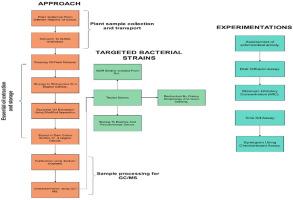Native oregano essential oil: Phytochemical composition, antibacterial and synergistic activities with oxytetracycline against multi-drug resistant (MDR) Bacteria
IF 3.5
3区 医学
Q3 IMMUNOLOGY
引用次数: 0
Abstract
Essential oil, particularly extracted from the aromatic plant Origanum vulgare (OEOs), exhibits antibacterial and anti-biofilm activity against multidrug-resistant (MDR) bacteria. In the current study, Origanum vulgare essential oil, a native herb of Pakistan, was tested against two novel MDR bacterial strains. These potential pathogens, isolated from the gut, have shown resistance to several antibiotics. The results indicated that the harvesting time significantly affected the oil yield, especially when the plant was collected in September 2024 during its full bloom. Extraction was performed using a modified Clevenger-type apparatus. The oil was tested against both strains: a Gram-positive bacterium, Bacillus licheniformis, and a Gram-negative bacterium, Pseudomonas azotoformans. Results demonstrated that oregano essential oil significantly inhibited the growth of both species, with a minimum inhibitory concentration of 1.25 μl/mL. The fractional inhibitory concentration index (FICI) was calculated after applying synergism using a checkerboard assay for both strains with the sensitive antibiotic oxytetracycline. Bacillus licheniformis exhibited a synergism value of 0.37, indicating strong synergism, whereas for Pseudomonas azotoformans, the FICI index was 0.50, reflecting successful synergism. This synergism helps to increase the efficacy of antibiotics and essential oils. Time-kill assays for oregano essential oil (OEO) demonstrate that within 7 h of incubation with OEO, it can completely kill Bacillus licheniformis, whereas for Pseudomonas azotoformans, the time required extends to 8 h. This approach could provide a sustainable solution for addressing the global antimicrobial resistance disease burden while also possibly reduce the economic burden for developing countries like Pakistan.

天然牛至精油:植物化学成分、抗菌及与土霉素对抗多重耐药(MDR)细菌的协同作用
精油,特别是从芳香植物Origanum vulgare (OEOs)中提取的精油,对多重耐药(MDR)细菌具有抗菌和抗生物膜活性。在目前的研究中,对一种巴基斯坦本土草本植物Origanum vulgare精油对两种新型耐多药菌株进行了测试。这些从肠道中分离出来的潜在病原体已显示出对几种抗生素的耐药性。结果表明,采收时间对油分产量有显著影响,特别是在2024年9月花期采收。采用改良的clevenger型仪器进行提取。该油对两种菌株进行了测试:革兰氏阳性细菌地衣芽孢杆菌和革兰氏阴性细菌偶氮假单胞菌。结果表明,牛至精油对两种病原菌的生长均有显著抑制作用,最低抑制浓度为1.25 μl/mL。采用棋盘法计算两种菌株与敏感抗生素土霉素的协同作用后的分数抑制浓度指数(FICI)。地衣芽孢杆菌的增效值为0.37,表明增效作用较强,而偶氮假单胞菌的增效指数为0.50,表明增效作用成功。这种协同作用有助于提高抗生素和精油的功效。牛至精油(OEO)的时间杀灭试验表明,在OEO的7小时内,它可以完全杀死地衣芽孢杆菌,而对于偶氮假单胞菌,所需时间延长至8小时。这种方法可以为解决全球抗菌素耐药性疾病负担提供可持续的解决方案,同时也可能减轻巴基斯坦等发展中国家的经济负担。
本文章由计算机程序翻译,如有差异,请以英文原文为准。
求助全文
约1分钟内获得全文
求助全文
来源期刊

Microbial pathogenesis
医学-免疫学
CiteScore
7.40
自引率
2.60%
发文量
472
审稿时长
56 days
期刊介绍:
Microbial Pathogenesis publishes original contributions and reviews about the molecular and cellular mechanisms of infectious diseases. It covers microbiology, host-pathogen interaction and immunology related to infectious agents, including bacteria, fungi, viruses and protozoa. It also accepts papers in the field of clinical microbiology, with the exception of case reports.
Research Areas Include:
-Pathogenesis
-Virulence factors
-Host susceptibility or resistance
-Immune mechanisms
-Identification, cloning and sequencing of relevant genes
-Genetic studies
-Viruses, prokaryotic organisms and protozoa
-Microbiota
-Systems biology related to infectious diseases
-Targets for vaccine design (pre-clinical studies)
 求助内容:
求助内容: 应助结果提醒方式:
应助结果提醒方式:


